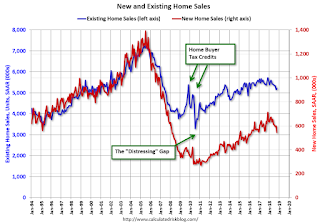by Calculated Risk on 11/28/2018 11:01:00 AM
Wednesday, November 28, 2018
A few Comments on October New Home Sales
New home sales for October were reported at 544,000 on a seasonally adjusted annual rate basis (SAAR). This was below the consensus forecast, however the three previous months were revised up significantly. Although weak, this was only a little below the initial report for September of 553,000 (now revised up to 597,000).
Sales in October were down 12.0% year-over-year compared to October 2017. The largest declines were in the Northeast, possibly due to a combination of higher interest rates and changes in the tax law.
On Inventory: Months of inventory is now above the top of the normal range, however the number of units completed and under construction is still somewhat low. Inventory will be something to watch very closely.
Earlier: New Home Sales decrease to 544,000 Annual Rate in October.

This graph shows new home sales for 2017 and 2018 by month (Seasonally Adjusted Annual Rate).
Sales are only up 2.8% through October compared to the same period in 2017.
And the comparison in November will be very difficult (Sales in November 2017 were strong). And sales might finish the year down from 2017,.
This is below my forecast for 2018 for an increase of about 6% over 2017. As I noted early this year, there were downside risks to that forecast, primarily higher mortgage rates, but also higher costs (labor and material), the impact of the new tax law, and other possible policy errors.
And here is another update to the "distressing gap" graph that I first started posting a number of years ago to show the emerging gap caused by distressed sales. Now I'm looking for the gap to close over the next several years.

Following the housing bubble and bust, the "distressing gap" appeared mostly because of distressed sales. The gap has persisted even though distressed sales are down significantly, since new home builders focused on more expensive homes.
I still expect this gap to slowly close. However, this assumes that the builders will offer some smaller, less expensive homes. If not, then the gap will persist.
Note: Existing home sales are counted when transactions are closed, and new home sales are counted when contracts are signed. So the timing of sales is different.


